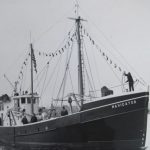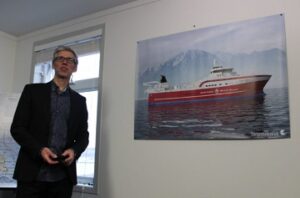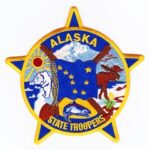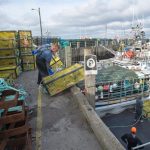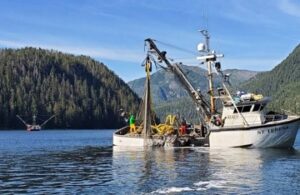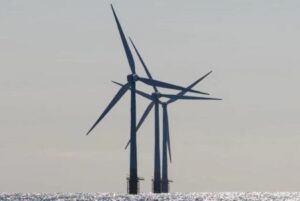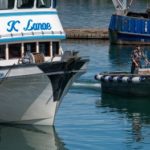Tag Archives: R/V Bigelow
NOAA Fish Surveys: A way to improve – Capt. Sam Novello
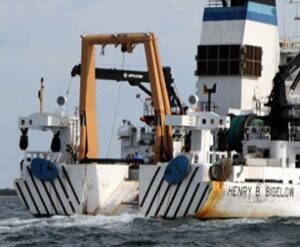 First, you need the net, then a set of doors capable of spreading, the net and ground wire, and bridles connected to the net. The angle of attack should be at 15 degrees, this angle is best for catching flounders, cod and haddock. The lower of the angle will catch more flounders. This is the reason why R/V Bigelow did an inadequate job of catching flounders & codfish, (overspreading the net) The best net will not fish properly if the doors are not synchronized with the net. People are talking about a new net for fish surveys, which means more research is needed, more time lost and more money wasted. >click to read< 13:30
First, you need the net, then a set of doors capable of spreading, the net and ground wire, and bridles connected to the net. The angle of attack should be at 15 degrees, this angle is best for catching flounders, cod and haddock. The lower of the angle will catch more flounders. This is the reason why R/V Bigelow did an inadequate job of catching flounders & codfish, (overspreading the net) The best net will not fish properly if the doors are not synchronized with the net. People are talking about a new net for fish surveys, which means more research is needed, more time lost and more money wasted. >click to read< 13:30
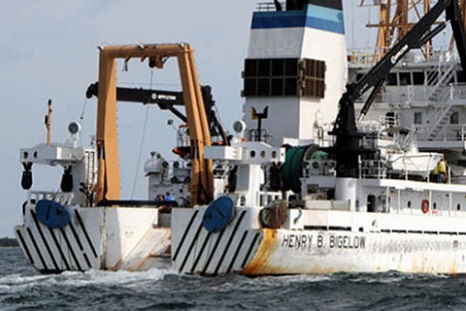
R/V Bigelow: Overspread, Under spread, or the Perfect spread.
Today both commercial and recreational fishermen believe that NOAA’s Northeast Fisheries Science is problematic while N.E. Trawl Panel Members who regulate the R/V Bigelow net, state there is a problem of over and under spreading which causes the net to fish inadequately. The N.E. Trawl Panel wants to put a Restrictor Wire between the trawl doors to stop the overspreading. I believe what they want to do will not work adequately, because if one door hits an obstacle the other door will be affected. Another issue would be dragging wire on the bottom of the ocean between the doors will affect the herding of fish. What will it take to address and fix the overspreading and under spreading and achieve the perfect spread at all times? >click to read< 21:01 Thank you, Captain Salvatore Novello, Gloucester, Massachusetts
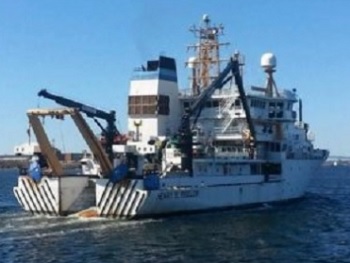
To Whom This May Concern: Over-Spreading of R/V Bigelow Net
I believe that the Over-Spreading of NOAA’s nets used on their surveys began in the 1970s when NOAA changed from an old side-trawler which towed from the side of the vessel & the main towing wires were together. Then came the NOAA’S modern stern-trawlers & the main towing wires put 18 feet apart from each other wire. (R/V Delaware 2) R/V Bigelow main wires are 38 feet apart which causes over-spreading!! Northeast Trawl Advisory Panel has another problem with R/V Bigelow’s net. It under-spreads in shoal waters,,, >click to read< 19:32 By Sam Novello
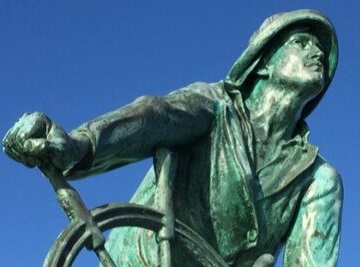
New England’s Cod Quota Drops Again! The Problem Could Be a R/V Bigelow Trawl Issue
To whom this may concern. The Northeast Trawl Advisory Panel has been working on the overspreading issue and their solution is to put a restrictor rope between the doors to keep them from overspreading the net. This is not a realistic solution, as different depths need different lengths of wire, also one door striking a big rock, or any hang would affect the track of the other door. My question is why is overspreading occurring?!! >click to read<, Respectfully, Captain Sam Novello, Gloucester, Mass 22:23

Finding Common Ground Off to a bad start
The opinion piece “Finding common ground on fisheries data”, reflects the biggest impediment to solving the problems it addresses – lots of false assumptions. First and foremost is blaming reductions in survey fish stocks on “overfishing”. Yes, overfishing did occur when massive, mostly foreign, commercial fishing operations scooped up fish stocks indiscriminately, often purging the bottom of everything needed to sustain acquatic life. But this was not done by the small boats of the New England fishing communities, which now, after thirty years of draconian restrictions, are no longer capable of catching enough fish to sustain their boats and their families — never mind “overfishing”. >click to read<, Capt. Salvatore “Sam” Novello, Gloucester, Mass. 08:30
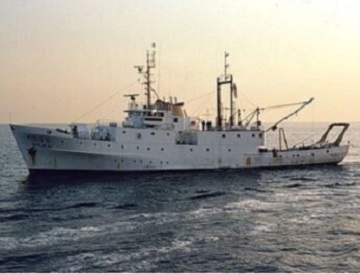
Groundfish Trawl Task Force – Finding common ground on fisheries data
Building consensus between commercial fishermen, conservationists and marine regulators is no easy task. But a long, patient effort led by Congressman Seth Moulton’s office seems to be making progress,,, For years, NOAA has relied on data from two research trawlers. The Albatross IV was used between 1963 and 2008, and the Bigelow since then. NOAA currently combines data from both vessels when making regulatory decisions. That is despite the often-flawed data supplied by the Albatross IV over the years. The Albatross IV was at the center of the “Trawlgate” controversy of the early 2000s, when NOAA scientists had to concede the trawler used the wrong nets, likely missing hundreds of thousands of fish. Yet regulators stood by that data to set low catch limits based on the admittedly flawed numbers. >click to read< 10:25

Trawl Task Force Wins But Fishing Methodology Between N.O.A.A. and Commercial Fishing Today Is Vastly Different
To Whom This May Concern: First I will talk about N.O.A.A.‘s methodology of fishing when their fishing survey was started to find the abundance of fish, but tows were randomly picked, tows were 20 minutes long, using a net which was too small for the boat and the area covered by the bouncing net and wire was minor compared to today’s commercial fishing tows. At that time, these surveys had No Quota Effects on Commercial Fishing. Times have changed since then, BUT NOW N.O.A.A. surveys control fish given to commercial fishing by their inadequate surveys methodology. >Click to read< by Sam Novello, a Gloucester fisherman who cares about the future of fish and fishermen. 23:30
New England Fishermen needlessly on the hook for uncertainties of stock estimates
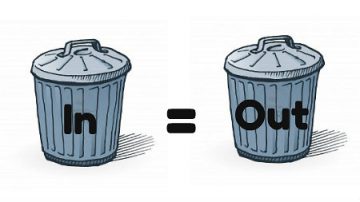 Proper stock assessments are the key to sound fisheries management here in New England. The current and now primarily survey-based assessments are heavy with uncertainty and always assumed to be overstated. Given the changes in the available stock assessment data created by 20 years of regulations, the uncertainty only seems to be increasing. The fact that the R/V Bigelow, the National Oceanic and Atmospheric Administration’s primary fishery research vessel, delayed the survey this year is a significant threat to fishermen: We have been told that there are very few codfish in the Gulf of Maine, but this spring, fishermen have found it impossible to set a net in the water without catching codfish. This does not correlate well with the assessment advice. Read the rest here 07:42
Proper stock assessments are the key to sound fisheries management here in New England. The current and now primarily survey-based assessments are heavy with uncertainty and always assumed to be overstated. Given the changes in the available stock assessment data created by 20 years of regulations, the uncertainty only seems to be increasing. The fact that the R/V Bigelow, the National Oceanic and Atmospheric Administration’s primary fishery research vessel, delayed the survey this year is a significant threat to fishermen: We have been told that there are very few codfish in the Gulf of Maine, but this spring, fishermen have found it impossible to set a net in the water without catching codfish. This does not correlate well with the assessment advice. Read the rest here 07:42
Our View: Fishery managers need management | SouthCoastToday.com
 UMass Dartmouth’s School of Marine Science and Technology, housed in New Bedford’s South End, wrote the book on scallop surveys. SMAST’s peer-reviewed survey data convinced federal regulators the fishery wasn’t collapsing and that closed areas could be opened and managed for sustainability. The school built on a shoestring budget equipment that showed scallop populations were healthy, in contradiction to data gathered by improperly calibrated government equipment. So we ask: Why squeeze SMAST out of the process by cutting its allocation of Research Set-Aside funds from $500,000 to $100,000?
UMass Dartmouth’s School of Marine Science and Technology, housed in New Bedford’s South End, wrote the book on scallop surveys. SMAST’s peer-reviewed survey data convinced federal regulators the fishery wasn’t collapsing and that closed areas could be opened and managed for sustainability. The school built on a shoestring budget equipment that showed scallop populations were healthy, in contradiction to data gathered by improperly calibrated government equipment. So we ask: Why squeeze SMAST out of the process by cutting its allocation of Research Set-Aside funds from $500,000 to $100,000?
http://www.southcoasttoday.com/apps/pbcs.dll/article?AID=/20120831/OPINION/208310302/-1/NEWS01

































